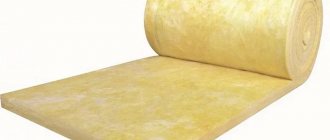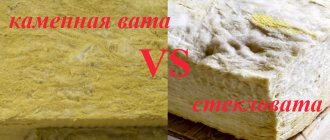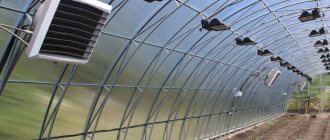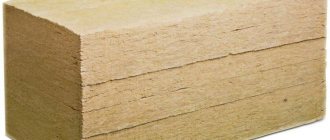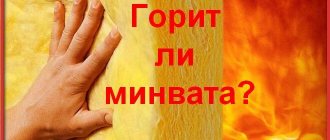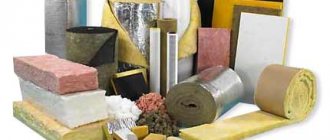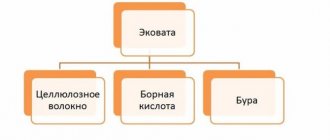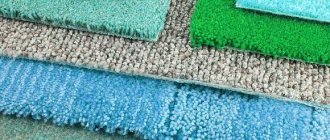Insulation of building structures plays a huge role in maintaining the energy efficiency of a building. The better it is produced, the less expenses are spent on heating, and the longer the life of the house and the more comfortable its microclimate. And the main requirement for thermal insulation is low thermal conductivity, high density, fire safety, good vapor permeability and durability. And this is what fibrous materials like cotton wool can primarily boast of.
Mineral wool is a long-studied and environmentally friendly material with excellent soundproofing properties, low thermal conductivity, biological and chemical resistance, as well as resistance to temperature and mechanical deformation. But everything from this list directly depends on the production technology and the raw materials used.
So let's figure it out, which is better: basalt wool or mineral wool based on slag and glass? Why do you need to wear almost a spacesuit when working with one material, while with another you don’t even need gloves? What is more advisable to purchase to insulate your own home in order to be sure of its durability? We will tell you all about this now.
What is mineral wool and what types does it come in?
Let's start with the fact that mineral wool today is produced both for insulation and for insulating a wide variety of surfaces: from roofs and partitions to high-temperature systems and even water supply lines. It is environmentally friendly, inexpensive and easy to install.
Mineral wool fibers come in a variety of lengths and thicknesses. They are made from minerals, as the name suggests, and, for comparison, there are also fibers made from organic matter. Mineral fibers, depending on the raw material, form glass wool, slag wool and basalt wool, that is, stone wool. Let us also note this important point. In fact, stone wool is mineral wool, because... Yes, it is included in the group of these materials. Therefore, if we compare them all with each other, then in terms of advantages it is basalt wool over glass or slag wool.
The whole secret of how such insulation works is that it traps air and does not allow cold to pass through. Speaking in the language of builders, it has low thermal conductivity. That is why it is customary to install insulation between two spaces that differ in temperature and air humidity. These are walls, floor, ceiling and partitions.
Air is generally the most effective heat insulator. Therefore, high-quality mineral wool is precisely a lush air layer of fibers of different lengths and thicknesses, and in Russia it is produced according to GOST 52953-2008 only from non-combustible materials:
Here is an interesting comparison of both types of material with small experiments (we do not recommend repeating it at home):
How does stone wool differ from other types of mineral insulation?
If we consider the features and characteristics of basalt insulation, a number of advantages of stone wool over other analogues of thermal insulation materials will become noticeable. One of the most important factors of this material is considered to be a good degree of biological and chemical properties. activity. This fact makes it possible to compare favorably with other insulating materials, for example, from the same glass wool.
The heat insulator, for the production of which basalt was used, has a special structure, which has short and thick fibers, so the level of plasticity of the insulation increases greatly. In addition, the likelihood that the material will fall off during installation is minimized.
Technological module for the production of insulation materials
Mineral fiber manufacturing technology
As we have already said, depending on the raw materials and the technology used, each insulation will differ in the thickness and orientation of the fibers. In this case, the fibers can be arranged spatially, corrugated, in horizontal or vertical layers, depending on what equipment they were melted on.
But the general principle is this:
As a result of production, mineral wool of different colors, thicknesses and fiber lengths is obtained, which directly affects its properties. On the Russian market, all three types have this cross-sectional view:
The prickly, ubiquitous glass wool
Cylindrical glass wool is now actively used for thermal insulation of pipelines, and in the form of slabs - for ventilated facades. This material is even used in aviation! They are used to decorate cabins to achieve the necessary protection against heat loss and muffle sounds. Glass wool also always insulates components that get too hot.
Glass wool is good because it can withstand vibration loads well. It is made from dolomite, sand, limestone or cullet. Usually it is yellow, very light or more saturated (abroad - more often pink).
The process itself is simple: broken glass or its equivalent is heated to almost one and a half thousand degrees until the glass begins to melt. Then thin fibers with a thickness of 5 to 15 microns and a length of 15 to 50 mm are easily drawn from them. The threads dry out and curl into cotton wool:
The material is quite strong and elastic, but it is not easy to work with. The fact is that all these glass fibers are quite fragile, and when they break, they fall on the skin and eyes in the form of thousands of small sharp needles, causing redness and irritation.
And if you inhale glass dust, it will be bad for your lungs. That is why they work with such material only in a protective suit and a respirator, although there are many extreme sports enthusiasts.
Reliable and fireproof stone wool
Stone wool is made by alloying rocks and a mixture of metallurgical slags. The raw materials used are basalt, diabase, or gabbro with the addition of limestone or dolomite rocks. Vapor permeability – within 0.25-0.35 mg/m²*h*pa. Such thermal insulation costs significantly more than glass wool, but it also has completely different characteristics. But in terms of heat and sound insulation, both materials are similar.
By the way, for some roofing structures only basalt wool, which is quite tensile strength, is suitable. Neither glass wool nor slag wool can boast of this quality.
Available and soft slag wool
Another common mineral wool insulation is slag wool, produced from waste from the metallurgical industry. Such raw materials are obtained during the melting process in coke cupola furnaces. The so-called cupola method, which improves the physical and mechanical properties of wool and reduces the cost of the process.
The only negative is that during the production of blast furnace slag the acidity indicator remains unstable. After all, the blast furnace slag itself for slag wool is obtained in the process of smelting cast iron. Because of this, mineral wool in different packages may differ slightly in its properties and reactions to environmental influences.
Those. It may turn out that your neighbor’s attic, insulated with the same brand of slabs, can last longer than yours. In a word, it is difficult to predict the end result here. And the threads themselves are obtained from molten blast furnace slag, with a thickness of 4 to 12 microns and a length of 16 mm. The result is quite elastic and heat-insulating wool. Its thermal conductivity coefficient is 0.46 - 0.48 W/(m∙k).
Also, residual acidity in a damp room can negatively affect metal surfaces. Slag wool absorbs moisture quite quickly, and therefore cannot be used for insulation in the bathroom. Because of these features, plastic and metal pipes are never insulated with it. But it is not suitable for finishing the facade at all.
But slag wool does not prick like glass wool, although its dust often floats in the air and creates an unpleasant sensation when inhaled. Also, unfortunately, slag wool contains formaldehyde resin, which releases phenol.
This is unsafe for human health, so during the installation process you must especially carefully observe safety precautions. It is important to cover such insulation with a vapor barrier film without gaps. Although this also applies to the previous two types.
Let's put the definitions in order!
In order to have a truly meaningful conversation with the reader, it is necessary to clarify the further use of terminology. And judging by the title in the title, it is very far from correct.
Expert opinion: Afanasyev E.V.
Chief editor of the Stroyday.ru project. Engineer.
I wonder what answer you would find, for example, if you were asked the following question: “what is better – a car or a passenger car?” Or, let’s take an even more paradoxical one: “Which do you like better – trees or birches?” Surely you will look at the person who asked such a question with some wariness and, perhaps, “twist your finger at your temple.”
Meanwhile, these formulations of the question are no more absurd than the one in the title of the article! Don’t believe me, do you think that the author just decided to “get smart”? Well, let's turn to the source and go through the chain of definitions to the points that interest us.
In this case, the primary source will be GOST 31913-2011 .
A document that brings order to definitions in the field of use of thermal insulation materials. By the way, please note that the standard is not just state, but even interstate.
The standard has interstate status, or more precisely, it can be considered a Russian-language version of the European standard EN ISO 9229:2007 . And for the basic terms used in it, even in the Russian edition, the accepted international name (in English) is indicated.
So, let's look:
Clause 2.1.13 - it combines all types of fiber insulation.
“Thermal insulating material consisting of natural or artificially obtained fibers.” In the English version – “fibrous insulation”.
It is clear that natural fibers (cotton, linen, cellulose, etc.) are not of interest to us in this case. But mineral ones - they are negotiated separately.
Clause 2.1.15 – under the collective image of mineral fiber (English – “mineral fibre”) all fibers of inorganic nature are hidden, with the exception of metallic ones.
It also includes subclause 2.1.15.1 - about artificial mineral fiber (English: “man-made mineral fiber”, which includes what is obtained in industrial conditions from glass melts, rocks, slag, clay, metal oxides, etc.). P.
But now we come close, that is, literally verbatim, to our problem.
Clause 2.1.16 directly talks about the concept of “mineral wool” (English: “mineral wool” or abbreviation MW). This term refers to fibrous thermal insulation materials obtained from molten glass, rocks or slag. And then there are three subparagraphs that completely reveal the whole picture:
2.1.16.1 - glass wool (English: “glass wool”) - obtained mainly from melts of broken glass or natural quartz sand.
2.1.16.2 - rock wool (English: “rock wool” or “stone wool”) - from rock melts of volcanic origin.
2.1.16.3 - slag wool (English: “slag wool”) - obtained from blast furnace slag melts.
Here we can put an end to the dispute - so which is better, mineral or stone (basalt)? Are there still any ambiguities about the incorrectness of the question?
And if we carry out a “showdown”, then rather in this vein - which of the mineral wools is better to use for home insulation: stone wool, glass wool, or slag wool?
But here, it must be said, the “leadership” of one of the listed insulation materials is clearly visible. This can be displayed with this kind of rating.
Comparison of technical characteristics: which raw materials are better?
Any insulation is always subject to such important requirements as heat retention and durability. In this, mineral wool has a significant advantage over other types of thermal insulation materials (despite the fact that glass wool has a service life of only 7 years).
At the same time, all manufacturers are actively working to improve their products, constantly conduct research in their laboratories and make sure that their products are convenient and safe for insulating ordinary residential buildings. This can't help but rejoice!
As for raw materials, we can say that there are no bad insulation materials, it’s just that each option is better suited for a specific construction task. That is why it is so important to know the technical characteristics of all three types of mineral wool and their differences from each other.
Thermal conductivity and elasticity
So, let's start with thermal conductivity, i.e. ability to retain heat by the material itself. For glass wool and basalt slabs it is at the same level. This is respectively 0.041 W/m*k and 0.038 W/m*k.
For your own interest, you can search for popular videos on Youtube, where craftsmen are actively testing different types of mineral wool. For example, sticking thermometers into pieces of insulation right on the street, and observing which of the insulation does its job better. The difference turns out to be literally 1-2 degrees, which cannot be called significant.
Next are density and elasticity, which affect the installation process and the weight of the structure. For some roofs, thermal insulation also performs load-bearing functions, for example, in the case of inversion roofs. Therefore, strength characteristics are more important here.
For example, fiberglass has a low density. This type of wool has a compressive strength of 40-45 kPa with a density of about 115 kg per m3. Due to this, the weight of glass wool is significantly lower than basalt.
By the way, the ability to compress and recover without deformation is clearly visible to the naked eye when the packages with insulation are opened:
The density of mineral wool also directly affects its final strength. The better the density, the stronger the insulation. These are important technical parameters that determine for what load one or another type of mineral wool can be taken.
Fire safety and fire resistance
As for fire safety, both mineral and basalt wool do not burn in a fire. At most, their fibers can be baked with each other at a certain temperature. For example, glass wool melts already at 300 degrees Celsius, slag fibers do not lose their properties even when heated to 700 degrees Celsius, and basalt wool can withstand even at 1000 degrees.
But keep in mind that if you choose stone wool based only on such considerations, this is not entirely true. The fact is that wool may not catch fire at a temperature of 1000 degrees Celsius, but waterproofing films and attic cladding definitely do.
The advantage of all types of mineral wool is that they themselves do not support open fire. If you compare them with foam and polystyrene products, then this is a valuable point.
The fact is that during the process of fire spread, polystyrene foam or expanded polystyrene not only burn actively, but also help the fire spread quickly and efficiently. They say about such houses that they “blazed up like a match”:
Cotton wool and skin irritation
Another important point regarding mineral wool. One of its main disadvantages is the harmful dust and causticity of the material itself. But not everyone knows that this is a typical sign of the presence of short and thin fibers in the insulation.
For pebbled boards, the fiber thickness is usually 0.02 mm and the length is less than 3 mm. Those. The thinner and shorter the fibers, the more they look like small needles. Even cutting such a slab is not very pleasant: it is reminiscent of touching dried bread, a lot of effort and a lot of crumbs everywhere. But the longer the fibers, the easier it is to work with them: they are easy to cut, generate almost no dust and do not irritate the skin of the hands.
Basalt wool has an order of magnitude fewer problems with this, and most modern products in this series do not require the use of special protective equipment at all, except for gloves. Although, in fact, glass wool is not such a bad material if you follow the installation instructions and take care of your own safety.
Unfortunately, even with all the awareness, many home craftsmen still have a certain recklessness, due to which they calmly take glass wool with their bare hands and do not care too much about tightly insulating it from the living room. And then these same people write negative reviews on manufacturers’ websites stating that their cotton wool is environmentally unsafe and generally unbearable for the human body.
Important environmental issues
Let's consider this important point. Almost all stone wool manufacturers produce an environmentally friendly product, without toxic substances, which does not emit any unpleasant odors into the room. This type of insulation is truly safe for human health. In addition, such factories even use waste-free production, which is also important for the environment.
As for the environmental safety of other types of mineral wool, such as glass or slag wool, there are several points in contrast to stone wool. Mineral wool may contain small amounts of phenol-formaldehyde resin. But in fact, even during the production process at high temperatures, it polymerizes and turns into an inactive solid state. It no longer remains in its free form, and it does not in any way affect people living in an insulated house. Although formaldehyde is still used to make glass wool.
In fact, stone wool, especially older ones, sometimes contains this substance. The whole problem is in the layered structure of cotton wool: the fibers are arranged chaotically, resulting in the formation of a large number of air pores. And derivatives of phenol-formaldehyde resin, as a binder, transform individual fibers into a strong and elastic fabric that does not crumble or sag. Those. this is a truly important component for production.
And cotton wool with this composition is more durable and stable. Therefore, some manufacturers still contain formaldehyde resin in stone wool, although much less - only from 2.5 to 10%. But the less formaldehyde, the less moisture-resistant the insulation itself, although this is precisely how the threat of benzene evaporation is reduced.
Of course, all these additives are usually contained within normal limits, which is relatively safe for humans and the environment. Today, special laboratories test mineral wool insulation for all these parameters. Moreover, the tests take place in several stages - this is a radiation assessment, a washout for general toxicity and an assessment of the release of harmful substances into the atmosphere.
To assess the level of organic substances in mineral wool, it is placed in a climate chamber for a day and kept at the desired temperature and air humidity for some time. This is how they check whether mineral wool meets the sanitary and hygienic requirements recognized in Russia.
That's why, if you're concerned about the environmental friendliness of a material, ask for a quality certificate. After all, today there is a rather tough struggle in the construction market and sometimes myths are spread about the unsafety of this or that insulation.
Durability and resistance to shrinkage
Another significant disadvantage of glass wool is its ability to shrink. It is because of this that it has a short lifespan, while stone wool is much more durable and retains its shape well for many years.
And if we talk about price, then, of course, glass wool is the most affordable. With all its shortcomings, it is great for rooms that first need sound insulation, and only then everything else.
Bonus: Express assessment of the required insulation thickness
The effectiveness of certain insulation materials is best assessed, so to speak, quantitatively. That is, an indicator of which layer of thermal insulation will be sufficient. And if at the same time there is an opportunity to make a comparison with other materials, then it turns out great.
We will provide you with this opportunity. Our online calculator will help you perform similar calculations and, if desired, make comparisons. Below we will give some explanations on working with it.
Express calculation calculator for insulation thickness.
Go to calculations
Explanations for working with the program
For starters, why express? Yes, simply because, without pretending to be completely professional, this algorithm allows you to very quickly “estimate” the thickness of the future insulating structure. And at the same time, with a fairly high degree of accuracy - the discrepancies with the final results of more advanced pro programs that take into account a lot of different nuances ultimately amount to a few millimeters. So, let's move on to sequentially indicating data in the fields of the calculator
- In the list of insulation materials, mineral wools are placed in the first positions - simply because our publication is dedicated specifically to them. But if you wish, you can carry out calculations for other materials from the proposed list - this helps many to determine the best option.
- The next point asks you to indicate the normalized value of heat transfer resistance. Where and how to get this indicator?
Where - it's easy! In the proposed map-scheme, having found your region of residence on it.
Map-scheme of indicators of normalized heat transfer resistance for building structures (by regions of Russia).
Be careful though! The values for different parts of the house structure are different:
- for walls - indicated in purple numbers;
- for floors (floors, ceilings) - indicated in blue numbers;
- for coverings (in particular, roofing, and this also includes the attic wall, which are, in fact, the reverse sides of the roof slopes) - indicated in red numbers.
- Next, it is proposed to indicate the features of the insulated structure - what it is made of (select a material from the list), and what its thickness is (in mm).
There is a nuance. In some cases there will be nothing to indicate. For example, insulating the roof from the inside, the roofing material itself is not taken into account. Or, say, a frame wall. Thin cladding on both sides can also hardly pass for a “major structure.” And so on - it’s not difficult to figure out. In such situations, regardless of the material specified in the list, it is enough to leave the thickness of the insulated structure equal to zero.
Expert opinion: Afanasyev E.V.
Chief editor of the Stroyday.ru project. Engineer.
It is possible to specify two more layers. For example, internal and external cladding of the wall, front surface of the floor, lining of the flow and attic floor - for the ceiling, internal cladding of the slope-wall for the attic, etc. The approach is the same - the material from the list and its thickness in millimeters. If there is no such layer, or there is no desire to take it into account in the calculations, simply leave the thickness equal to zero.
That's all - all you have to do is press the "CALCULATE" button and get the finished result in millimeters. This is the minimum thickness, and is usually reduced to standard insulation thicknesses, rounded up.
An example of two-layer wall insulation with mineral wool - cold bridges are reduced to a minimum.
And it’s even smarter to use two-layer insulation. For example, the result is shown at 138 mm, and it probably makes sense to place 100 mm thick mineral wool slabs as the first layer. And then, as a second layer, lay out another 50 mm ones, so that they completely cover the joints between the blocks of the first one. This way, cold bridges are almost completely eliminated!
Subtleties of installation and operation: some pitfalls
Both glass wool and basalt slabs are suitable for insulating building structures of a house. Both types of materials are supplied to the market in a format convenient for installation - slabs, rolls and mats with similar technical characteristics, which we discussed above:
All types of mineral wool are easy to install. They are slightly springy, they are quite easy to cut and insert between the rafters a little under tension. So that they are supported by their own weight and elasticity. The only thing is that glass wool and slag wool have less weight, and therefore create less load.
Slabs with a thermal conductivity of 0.037 W/m*k are suitable for insulating pitched roofs. Glass wool with such parameters will already have a low density, due to this it has less weight and elasticity, which will guarantee its tight fit to the structure itself:
Basalt wool is a little heavier and denser, but it is easier to cut, looks more neat and holds more securely without shrinking over time:
Also, stone wool is used to insulate floors:
To sum it up: the choice is yours. Both basalt and other mineral wool have a number of advantages and minor disadvantages. Therefore, be guided by their main technical characteristics, as well as your own expectations and requirements for thermal insulation.
Shrinkability
Shrinkage involves sliding or caking of the insulation after some time. If the tendency of the material to shrink is high, then voids without insulation may form and the thermal insulation of the building will deteriorate.
Here, the difference between basalt wool and mineral fiberglass wool lies in the improved structure of the first. Some of the basalt wool fibers are located vertically, which prevents caking throughout its entire service life. The same cannot be said about glass wool, which, if properly installed, can last for a long period, but will still shrink over time. Glass wool placed in horizontal structures is subject to shrinkage the most, where, in addition to caking, sliding of the material can occur.
